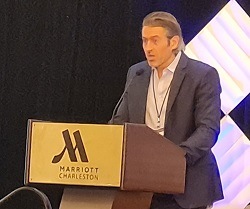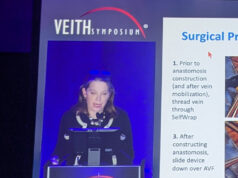
At this year’s Vascular Access for Hemodialysis Symposium (9–11 June, Charleston, USA), Alexander Toledo (University of North Carolina, Chapel Hill, USA) asserted the advantages of selectively ligating a patient’s arteriovenous fistula (AVF) following a successful kidney transplant—citing long-term medical, practical and cosmetic benefits.
Toledo began by noting that the average kidney graft survival time is 12–20 years for living donor transplants and 8–12 years for deceased donor transplants—and the most common reason for these grafts failing is the patient passing away, leading him to note that, “one way or another, most of our transplant patients will never need their dialysis access again”.
Listing factors that nephrologists and transplant surgeons may look at before deciding to ligate or preserve a fistula, the speaker said previous rejection episodes, presence of donor-specific antibodies and creatinine stability, as well as AVF characteristics like flow rate and whether the patient has other potential sites in case dialysis access is required in the future, may all be weighed alongside the likely lifespan of the kidney graft.
However, there is an absence of concrete guidelines on how to manage AVFs post-transplantation, he continued. “We are left with this conundrum: do we want to ligate the fistula, or preserve it?” Toledo said, noting that the possible benefits of ligation include reducing high flow through the access and lowering cardiac output. “These fistulas do put some degree of strain on the cardiopulmonary system and, if we do not need them, maybe the best approach is to ligate them,” he noted.
In addition to the risk of rupture that an open fistula carries, Toledo detailed a number of quality-of-life considerations from the patient’s perspective, including cosmetic advantages, reduced pain, and general improvements in their ability to work, play sports and go about their daily lives uninhibited. He did, however, also allude to the potential advantages of AVF preservation, namely maintaining the option for future haemodialysis access. Citing a study he and his colleagues carried out, Toledo also said that, while cost and surgical risk associated with ligation were minimal, these factors are “always a consideration in modern healthcare”.
The study in question involved more than 700 patients—52 of whom had their fistulas ligated post-transplantation and were followed up for a minimum of two years. “We looked at the indications for why we were ligating these fistulas,” he relayed, “and we found that only four of them were for strictly medical or cardiopulmonary reasons, such as high-output heart failure or a deep, excessive oedema of the arm.
“The vast majority of [ligations] were patient-driven. Some were caused by pain with the aneurysm or swelling in the arm, but there were also a lot of underrepresented factors that we do not traditionally consider when deciding if we want to ligate a fistula.” Toledo reiterated that cosmetic issues, including being able to wear short-sleeved clothing; job-related factors, like being able to perform manual labour or work in a kitchen without needing protective gear; and a desire to play with their children or return to contact sports, were all patient-reported factors in the study.
And, moving on to the outcomes of this study, the speaker stated that—in the properly selected patients—there were no returns to dialysis, episodes of readmission or any short- or long-term surgical complications. He did note, however, one reoperation that was required for arterial aneurysm development at two years, and three cases of neuropathy/pain, post-ligation.
Discussing future directions, Toledo highlighted artificial intelligence (AI), such as iBox (Cibiltech) and other emerging technologies, as a promising tool for stratifying post-transplant ligation candidates. He noted that these findings also point towards the importance of patient education regarding fistula management post-transplantation—as well as the potential role for personalised medicine in vascular access—and said that longer-term follow-up with a larger patient cohort is of interest too.
“Again, many of these post-transplant patients are not going to need their fistula or graft,” Toledo concluded. “There are potential medical benefits to AVF ligation and patient input is a valid consideration. I do believe this should be a routine aspect of post-transplant care—and, much further down the road, perhaps we will even have some criteria or guidelines that we can use.” In the interim, Toledo said he relies on the factors mentioned above and his transplant nephrology colleagues to make individualised decisions with post-transplant patients regarding ligation or preservation of their fistula.











